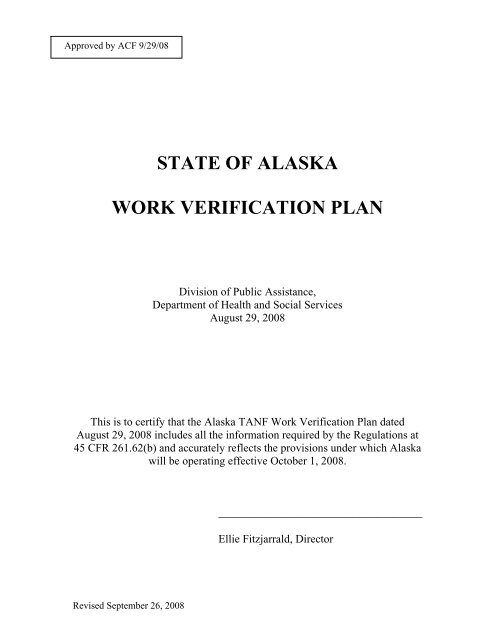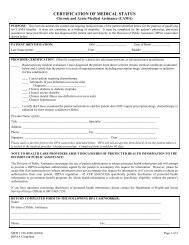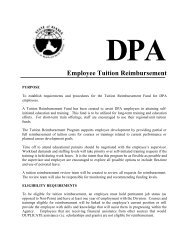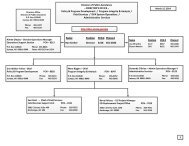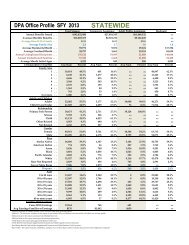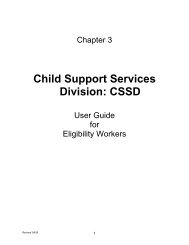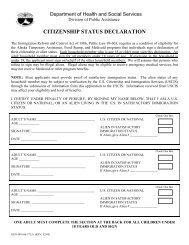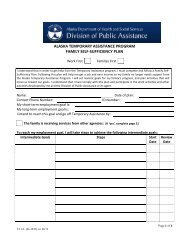STATE OF ALASKA WORK VERIFICATION PLAN - DPAweb
STATE OF ALASKA WORK VERIFICATION PLAN - DPAweb
STATE OF ALASKA WORK VERIFICATION PLAN - DPAweb
Create successful ePaper yourself
Turn your PDF publications into a flip-book with our unique Google optimized e-Paper software.
Approved by ACF 9/29/08<br />
<strong>STATE</strong> <strong>OF</strong> <strong>ALASKA</strong><br />
<strong>WORK</strong> <strong>VERIFICATION</strong> <strong>PLAN</strong><br />
Division of Public Assistance,<br />
Department of Health and Social Services<br />
August 29, 2008<br />
This is to certify that the Alaska TANF Work Verification Plan dated<br />
August 29, 2008 includes all the information required by the Regulations at<br />
45 CFR 261.62(b) and accurately reflects the provisions under which Alaska<br />
will be operating effective October 1, 2008.<br />
____________________________________<br />
Ellie Fitzjarrald, Director<br />
Revised September 26, 2008
State of Alaska<br />
Work Verification Plan<br />
Section I – Countable Work Activities<br />
Unsubsidized Employment<br />
Definition - Unsubsidized employment is full- or part-time employment in the public or<br />
private sector that is not subsidized by TANF or any other public program. Unsubsidized<br />
employment includes self-employment and seasonal employment. It also includes<br />
apprenticeships and internships when the participant receives a wage in these placements.<br />
Determination of Countable Hours - Documentation provided by the employer is used<br />
to determine the hours of unsubsidized employment. This documentation is pay stubs or<br />
other employer provided statements which substantiate the number of hours worked.<br />
Phone calls may be accepted if pay stubs or other employer provided statements are<br />
unavailable. Documentation gathered for determining eligibility is also used. This<br />
information is available in online Case Notes used by eligibility staff for documentation<br />
purposes.<br />
Once documented and verified, the actual hours worked as reported by the employer may<br />
be projected for up to 6 months if they represent continuing circumstances. This is done<br />
by averaging the reported hours for each week and counting this number of hours weekly<br />
for up to 6 months. If the actual hours worked in the initial month do not represent<br />
continuing circumstances, actual hours worked each month as verified by the employer<br />
are used. New documentation is required for the seventh month and following any<br />
reported change in hours of employment.<br />
For hours of self-employment, information gathered for determining eligibility is used.<br />
This information is available in online Case Notes used by eligibility staff for<br />
documentation purposes. The self-employed individual must provide documentation<br />
necessary to verify their gross income and the allowable costs of doing business for<br />
calculation of adjusted gross income. The adjusted gross income is divided by the federal<br />
minimum wage to estimate actual hours. Once the hours of self-employment have been<br />
calculated and verified, the estimated hours may be projected for up to 6 months if they<br />
represent continuing circumstances. This is done by averaging the reported hours for each<br />
week and counting this number of hours weekly for up to 6 months. If the estimated<br />
hours of self-employment do not represent continuing circumstances, a new estimate of<br />
actual hours must be calculated and verified. New documentation is required for the<br />
seventh month and following any reported change in self-employment income.<br />
In some situations the income from self-employment is irregular, subject to fluctuation,<br />
or, due to the nature of the self-employment enterprise (e.g., commercial fishing), may<br />
not be received in full in the month the work was done. In these cases, the adjusted gross<br />
income will be divided by the federal minimum wage and applied to the period of selfemployment.<br />
For example: A participant is a self-employed commercial fisher. The season lasts 5<br />
months. The eligibility technician, following allowable eligibility rules to determine<br />
Revised September 26, 2008 1
State of Alaska<br />
Work Verification Plan<br />
Section I – Countable Work Activities<br />
income from self-employment, uses prior year income tax records and other information<br />
about the expected level of fishing activities to calculate an adjusted gross countable<br />
income of $5,000 for the season or $1,000 per month. The projected monthly income is<br />
divided by the federal minimum wage to arrive at the projected hours of activity for each<br />
month of the fishing season.<br />
Verification of Countable Hours - Documentation provided by the employer to<br />
determine the hours of unsubsidized employment is also used for verification purposes.<br />
New verification is required every 6 months and following any reported change in hours<br />
of employment. Employer provided statements, including documented telephone<br />
contacts, will include the participant’s name, actual hours of work, name of the employer,<br />
and the name and phone number of the person verifying hours. The caseworker will<br />
document the information obtained from the employer in the case file.<br />
Self-employment – When self-employment income is received on a regular basis, the<br />
verification of the hours of self-employment is determined by dividing the participant’s<br />
adjusted gross earned income by the federal minimum wage. The information for<br />
determining adjusted gross earned income is verified through the eligibility determination<br />
process which follows strict program requirements for the determination and verification<br />
of self-employment income. The case manager will follow the policy and process the ET<br />
would use to make this determination in order to count hours of work participation. This<br />
process provides a degree of accuracy sufficient to determine eligibility for program<br />
benefits and it is considered adequate to calculate the hours of participation in selfemployment<br />
activities. The information used to calculate the hours of participation is<br />
documented in the case file.<br />
Monitoring/Supervision Procedures - Daily supervision is the responsibility of the<br />
employer. Hours of participation in self-employment are based on information gathered<br />
to calculate earnings for purposes of eligibility determination.<br />
Revised September 26, 2008 2
State of Alaska<br />
Work Verification Plan<br />
Section I – Countable Work Activities<br />
Subsidized Employment<br />
Definition - Subsidized employment is employment in the private or public sector for<br />
which the employer receives a subsidy from TANF or other public funds to offset some<br />
or all of the wages and costs of employing a recipient. The two types of subsidized<br />
employment countable in Alaska are:<br />
• Work study programs where students are employed by and receive wages from a<br />
public or private educational institution.<br />
• Job Start, the subsidized employment program operated by the State of Alaska,<br />
Division of Public Assistance. This program uses the amount of a TANF<br />
recipient’s benefit to offset a portion of their wages. The Job Start program<br />
requires that participants in subsidized jobs are provided a minimum of 35 hours<br />
of work per week. Job Start positions typically last from three to six months. The<br />
position cannot last more than 12 months. Employers participating in the Job<br />
Start program are required to complete an initial work site agreement that<br />
stipulates the hours the client will be employed. Supervisors are requested to<br />
immediately report attendance failures.<br />
Determination of Countable Hours - Documentation provided by the employer is used<br />
to determine the hours of subsidized employment. This documentation is pay stubs or<br />
other employer provided statements which substantiate the number of hours worked.<br />
Phone calls may be accepted if pay stubs or other employer provided statements are<br />
unavailable. Documentation gathered for determining eligibility is also used. This<br />
information is available in online Case Notes used by eligibility staff for documentation<br />
purposes.<br />
Once documented and verified, the actual hours worked as reported by the employer may<br />
be projected for up to 6 months if they represent continuing circumstances. This is done<br />
by averaging the reported hours for each week and counting this number of hours weekly<br />
for up to 6 months. If the actual hours worked in the initial month do not represent<br />
continuing circumstances, actual hours worked each month as verified by the employer<br />
are used. New documentation is required for the seventh month and following any<br />
reported change in hours of employment.<br />
Verification of Countable - Documentation provided by the employer to determine the<br />
hours of subsidized employment is also used for verification purposes. New verification<br />
is required every 6 months and following any reported change in hours of employment.<br />
Employer provided statements, including documented telephone contacts, will include<br />
the participant’s name, actual hours of work, name of the employer, and the name and<br />
phone number of the person verifying hours. The caseworker will document the<br />
information obtained from the employer in the case file.<br />
Revised September 26, 2008 3
State of Alaska<br />
Work Verification Plan<br />
Section I – Countable Work Activities<br />
Monitoring/Supervision Procedures - Daily supervision is the responsibility of the<br />
employer.<br />
Revised September 26, 2008 4
State of Alaska<br />
Work Verification Plan<br />
Section I – Countable Work Activities<br />
On the Job Training (OJT)<br />
Definition - OJT is training in public or private sector employment that is given to a paid<br />
employee while the person is engaged in productive work and where the individual gains<br />
knowledge, skills and abilities essential to the full and adequate performance of the job.<br />
The Alaska Division of Public Assistance OJT program reimburses participating<br />
employers in an amount equal to 50% of the participating employee’s wages for the costs<br />
of training the OJT participant. The wages the participant receives in the OJT position are<br />
used to calculate Temporary Assistance eligibility and benefits.<br />
Employers participating in this OJT program are required to work with the client and case<br />
manager to develop an individualized training plan for the client. The plan is designed to<br />
provide the participant with the knowledge, skills and abilities essential for a specific job<br />
and prepare the client to become a permanent employee following the training. OJT<br />
agreements completed by the employer require that participants in a full-time OJT<br />
position be provided a minimum of 35 hours of work per week and that part-time OJT<br />
positions provide a minimum of 20 hours of work per week. Participants may be assigned<br />
to an OJT placement for 3 to 6 months. The length of the placement may be adjusted to<br />
meet the needs of the employer and client. The OJT placement may not last longer than<br />
12 months.<br />
Determination of Countable Hours - Documentation provided by the employer is used<br />
to determine the hours of OJT. This documentation is pay stubs or other employer<br />
provided statements which substantiate the number of hours worked. Phone calls may be<br />
accepted if pay stubs or other employer provided statements are unavailable.<br />
Documentation gathered for determining eligibility is also used. This information is<br />
available in online Case Notes used by eligibility staff for documentation purposes.<br />
Once documented and verified, the actual hours worked as reported by the employer may<br />
be projected for up to 6 months if they represent continuing circumstances. This is done<br />
by averaging the reported hours for each week and counting this number of hours weekly<br />
for up to 6 months. If the actual hours worked in the initial month do not represent<br />
continuing circumstances, actual hours worked each month as verified by the employer<br />
are used. New documentation is required for the seventh month and following any<br />
reported change in hours of employment.<br />
Verification of Countable Hours - Documentation provided by the employer to<br />
determine the hours of OJT is also used for verification purposes. New verification is<br />
required every 6 months and following any reported change in hours of employment.<br />
Employer provided statements, including documented telephone contacts, will include<br />
the participant’s name, actual hours of work, name of the employer, and the name and<br />
phone number of the person verifying hours. The caseworker will document the<br />
information obtained from the employer in the case file.<br />
Revised September 26, 2008 5
State of Alaska<br />
Work Verification Plan<br />
Section I – Countable Work Activities<br />
Monitoring/Supervision Procedures - Daily supervision is the responsibility of the<br />
employer.<br />
Revised September 26, 2008 6
State of Alaska<br />
Work Verification Plan<br />
Section I – Countable Work Activities<br />
Work Search and Job Readiness<br />
Definition - Work search includes participation in Job Clubs or similar activities<br />
designed to orient participants to work search expectations and to provide support and<br />
guidance for job seekers. Individuals engaged in work search are required to register for<br />
work with the state’s Department of Labor and to participate in employability<br />
assessments. These are vocational assessments and/or screening for learning<br />
needs/disabilities, mental health, substance abuse, or domestic violence. Work search<br />
entails researching employment opportunities, preparation and submittal of applications,<br />
attending interviews and interview follow-up with prospective employers. Case<br />
managers may assign a specific number of direct contacts with employers based on the<br />
local job market and the work experience, skills, and abilities of the participant.<br />
Job readiness activities include workshops and training in life skills, basic workplace<br />
expectations, skills, and ethics, resume writing, job retention and advancement skills, and<br />
vocational counseling.<br />
Job readiness activities can include short-term substance abuse and/or mental health<br />
treatment, domestic violence counseling or rehabilitation activities. Clients selected for<br />
screening because of demonstrated challenges to self-sufficiency, and those who disclose<br />
issues, may be referred to a state approved service provider for assessment. The<br />
assessment may result in referral to a state approved treatment provider when warranted<br />
by the severity of the client’s condition and the condition’s impact on the person’s<br />
employability.<br />
Specific activities that are essential for an individual to prepare for self-employment are<br />
also considered job readiness activities. These activities are necessary for the participant<br />
to obtain employment. Activities for self-employment job readiness include development<br />
of a business plan, acquisition of necessary business licenses, certifications (e.g., health<br />
certificates for food preparation), and permits (e.g., commercial fishery or mining<br />
permits), consultation with the Small Business Administration (SBA), pursuit of loans<br />
through financial institutions or funding through grants or micro-enterprise options, and<br />
obtaining supplies, equipment and business property.<br />
Determination of Countable Hours - Expectations for participation in work search and<br />
job readiness are initially documented as part of the participant’s Family Self-Sufficiency<br />
Plan.<br />
Work Search - Actual countable hours are determined by sign-in sheets at regularly<br />
scheduled Job Club sessions and workshops. Work search participants are required to<br />
research employment opportunities and prepare applications, resumes, etc., at job center<br />
resource rooms or at resource rooms operated by Work Services providers. When clients<br />
have multiple interviews and are applying with multiple employers on the same day, the<br />
travel time in between interviews and applications can be counted. Travel to the first<br />
Revised September 26, 2008 7
State of Alaska<br />
Work Verification Plan<br />
Section I – Countable Work Activities<br />
interview or potential employer, lunch breaks, and travel home from the final interview<br />
or potential employer, are not counted.<br />
Clients are required to pursue a specific number of appropriate job leads each day as part<br />
of the work search activities. The actual number of leads is driven by the local job<br />
market and the client’s employability assessment. Clients are required to maintain job<br />
search logs that provide case managers with information regarding each employer contact<br />
(e.g., employer name and contact information, and the start and end times for each<br />
interview).<br />
Job Readiness - Clients participating in job readiness workshops sign attendance sheets<br />
that document their participation. Hours of participation in job readiness workshops and<br />
training are based on the scheduled hours for these activities as set by the service<br />
provider delivering the training.<br />
Clients who the case manager determines have a specific barrier to employment, or who<br />
persistently demonstrate an inability to meet self-sufficiency objectives and milestones<br />
necessary to prepare for employment, may be referred for screening and/or assessment to<br />
an approved provider (e.g., licensed by the state to provide the service). When<br />
documentation from the provider is obtained showing that treatment is necessary,<br />
treatment hours are countable. Hours of participation will include hours in family<br />
assessment and evaluation; individual, group, and family therapy; and mental<br />
health/substance abuse case management.<br />
Job Readiness for Self-employment - Individuals are required to maintain a log of<br />
activities related to preparation for self-employment. The log will note actual time on<br />
tasks and provide contact information for individuals or organizations (e.g., financial<br />
institutions, licensing, SBA, etc.) the participant is working with to initiate the selfemployment<br />
activities.<br />
Verification of Countable Hours - Work Search: Attendance records maintained by Job<br />
Club session facilitators serve to verify participation in the activity. Job Search activities<br />
are verified through review of the job search log and interactive de-briefing sessions with<br />
the participant’s case manager. The case manager will make random checks of reported<br />
employer contacts if the information appears questionable. Case managers document this<br />
information in the case file along with the actual time necessary to de-brief clients on job<br />
search experience and provide coaching and additional job leads.<br />
Job Readiness: These activities are verified through review of the participant’s activity<br />
log and interactive de-briefing sessions with the participant’s case manager. The case<br />
manager will make random checks of reported contacts if the information appears<br />
questionable. Case managers document this information in the case file as well as the<br />
actual time spent with the client reviewing progress on job readiness activities. Case<br />
managers who assign job readiness workshops to clients verify the hours of participant<br />
Revised September 26, 2008 8
State of Alaska<br />
Work Verification Plan<br />
Section I – Countable Work Activities<br />
attendance in the workshop with the instructor or presenter. Hours of participation in<br />
treatment programs, rehabilitation services, and employability assessments are verified<br />
through documentation from the provider licensed by the state to conduct assessments<br />
and provide treatment or therapy. This information is retained in the case file.<br />
Job readiness for Self-Employment - These activities are verified through contacts with<br />
individuals and organizations identified on the participant’s activity log. Hours may also<br />
be verified by written statements from contacts verifying the participants time spent on<br />
tasks. The information obtained is documented in the case file.<br />
Monitoring/Supervision Procedures - Participants in activities at Job Centers or other<br />
facilities operated by Work Services contractors are monitored daily by resource room<br />
staff, Job Club facilitators, and/or the case manager assigned to the participant. Clients in<br />
job readiness activities are monitored by the provider delivering the specific services.<br />
The actual job search activities of program participants are monitored after the fact<br />
through interactive interviews/de-briefings with the case manager and monthly review of<br />
the client’s weekly job search log.<br />
Note: Case managers use a specific work activity code for work search/job readiness.<br />
Case managers enter the start and end date for the activity and the actual, verified hours<br />
of participation for the month. This information is downloaded into the database used by<br />
the division to report participation. The State’s 12-week limit on reporting job search and<br />
job readiness is monitored by matching the previous 11 months federal TANF data to the<br />
current month’s TANF data to check the number of weeks each adult reported any<br />
amount of job search and job readiness. For the purposes of reporting federal TANF<br />
data, a week of job search and work readiness activities is defined as 20 hours for a single<br />
custodial parent with a child under age 6, and 30 hours for all other work-eligible<br />
individuals. Once an adult has had a total of 240 hours for a single parent with a child<br />
under age 6, or 360 hours for other adults, job search and job readiness hours reported,<br />
we report zero hours of job search and job readiness in all subsequent TANF Data<br />
Reports. We do not report an adult’s hours of job search and job readiness for the week<br />
directly following the 4 th consecutive week where they had any amount of job search and<br />
job readiness hours reported.<br />
The ACF website http://www.acf.hhs.gov/programs/ofa/pi-ofa/12weekqualifier.htm is<br />
used to check Alaska’s eligibility to allow 12 weeks of job search. Information about a<br />
change in the needy state designation will not be available until 3 months after the month<br />
in which recipients were assigned to job search for more than 6 weeks. When such<br />
information is received, the month's data will be reprocessed to make the necessary<br />
adjustments and the report resubmitted.<br />
Revised September 26, 2008 9
State of Alaska<br />
Work Verification Plan<br />
Section I – Countable Work Activities<br />
Business Work Experience (BWE)<br />
Definition - Business Work Experience (BWE) is unpaid work with a private sector<br />
for profit employer that provides an individual with an opportunity to acquire the<br />
general skills, training, knowledge, and work habits necessary to obtain paid<br />
employment. The purpose of work experience is to improve the employability of<br />
those who cannot find unsubsidized employment.<br />
BWE placements are short-term, not to exceed 3 months, and are intended to allow a<br />
client to test jobs that are related to their occupational goals. The placement also<br />
provides clients with an opportunity to develop and improve workplace ethics, to<br />
establish relevant and transferable work skills, and to develop contacts and references<br />
in the business community. Placements can be made with any business that is free<br />
from wage and hour disputes or violations. Each participating business must sign a<br />
Work Experience Site agreement.<br />
Work Experience placements must not:<br />
• Displace any currently employed worker, including partial displacement through a<br />
reduction in hours of overtime, wages, or benefits<br />
• Fill any positions vacated by a layoff or a reduction in force, or a position being<br />
left vacant due to lack of funding and must not infringe on the promotional<br />
opportunities of any individual currently employed by the work site<br />
• Prevent a laid off worker from filling a similar vacant position<br />
• Cause the imposition of fines or penalties against a participant by a labor union<br />
Determination of Countable Hours - The number of allowable hours for all work<br />
experience activities is calculated by dividing the TANF recipient’s cash benefit by<br />
the state’s minimum wage. State and/or contract case management staff solicits BWE<br />
work sites. Each site is required to complete a Work Experience Site Agreement<br />
which documents the client’s scheduled hours of activity.<br />
Verification Procedures - BWE participants have the site supervisor approve and<br />
sign an hour and attendance form. The form is submitted to the case manager every<br />
two weeks. Case managers also periodically contact the BWE site supervisor to<br />
identify and address performance issues. This information is retained in the case file.<br />
Monitoring/Supervision Procedures - Work experience participants are monitored<br />
or supervised at the work site as if they were an employee. Site supervisors are<br />
instructed to immediately report attendance failures. Case managers, or other staff<br />
responsible for developing BWE sites, periodically contact the site for the purposes of<br />
evaluating progress.<br />
Revised September 26, 2008 10
State of Alaska<br />
Work Verification Plan<br />
Section I – Countable Work Activities<br />
Community Work Experience (CWE)<br />
Definition - Community Work Experience (CWE) participants acquire job skills, recent<br />
work experience, network with potential employers, and contribute valuable services to<br />
their communities. Participants acquire knowledge, skills, and work ethics that<br />
employers find beneficial when seeking new employees. Whenever possible the work<br />
assignment includes work duties that match the participant’s vocational interests and<br />
enhance their skills and ability to find paid employment.<br />
Only public sector organizations or registered non-profit corporations can be considered<br />
as CWE sites. Participating non-profits must sign a CWE site agreement. For<br />
consideration as an appropriate work site, the non-profit organization must have an IRS<br />
501c.3 status. In addition, the purpose of the 501c.3 non-profit organization, as<br />
recognized by the IRS, is limited to the following six specific non-profit types:<br />
• Religious<br />
• Charitable<br />
• Civic<br />
• Cemetery<br />
• Recreational<br />
• Educational<br />
Placements can also be made with federal, state, or local government agencies, including<br />
public school districts. The work site representative must certify that the site is<br />
governmental or an allowable IRS 501c.3 non-profit organization.<br />
Note: Not all IRS 501c.3 non-profit organizations are acceptable work sites. Community<br />
Work Experience placements are limited as described above. When the non-profit status<br />
is undetermined, a corporation officer must provide a copy of the IRS 501c.3 verification.<br />
CWE includes subsistence activities which are defined as the non-commercial,<br />
customary, and traditional harvest of wild, renewable resources for use as food,<br />
shelter, fuel, clothing, tools, crafts, or transportation, and that contribute directly to<br />
the common good of the community and achieve a useful public purpose. This is<br />
accomplished through the distribution of harvested resources throughout the<br />
community using traditional and customary social networks. Subsistence activities are<br />
considered work activities when paid employment or other community work<br />
experience placements are unavailable.<br />
Determination of Countable Hours - The number of allowable hours for all work<br />
experience activities is calculated by dividing the TANF recipient’s cash benefit by<br />
the state’s minimum wage. State and/or contract case management staff solicits CWE<br />
sites. Each site is required to complete a Community Work Experience Site<br />
Agreement which documents the client’s scheduled hours of activity. Hours in<br />
Revised September 26, 2008 11
State of Alaska<br />
Work Verification Plan<br />
Section I – Countable Work Activities<br />
subsistence activities are determined from documentation provided by an overseeing<br />
agency or organization that includes the number of hours of participation and an<br />
explanation of how the activity directly contributed to the common good of the<br />
community and achieved a useful public purpose.<br />
Note: Self-initiated community work experience, that is not a subsistence activity, is<br />
only allowed if and when it meets the standards the state has set for CWE sites.<br />
Specifically, it must be operated by public or private non-profit organizations or by<br />
federal, state, or local government agencies, or public school districts.<br />
Verification of Countable Hours - CWE participants have the site supervisor<br />
approve and sign an hour and attendance form. The form is submitted to the case<br />
manager every two weeks. Case managers also periodically contact the CWE site<br />
supervisor to identify and address performance issues. For subsistence activities, the<br />
participant must provide documentation from an overseeing agency or organization<br />
that verifies their attendance and performance of subsistence tasks. The information<br />
obtained is retained in the case file.<br />
Monitoring and Supervision Procedures - CWE participants are monitored or<br />
supervised at the work site as if they were an employee. Site supervisors are<br />
instructed to immediately report attendance failures. Case managers, or other staff<br />
responsible for developing CWE sites, periodically contact the site for the purpose of<br />
evaluating progress. Monitoring of participation in subsistence activities is done by<br />
the overseeing agency or organization providing documentation of the activity.<br />
Revised September 26, 2008 12
State of Alaska<br />
Work Verification Plan<br />
Section I – Countable Work Activities<br />
Vocational Education and Training<br />
Definition - Vocational education and training includes organized educational<br />
programs which are directly related to the preparation of individuals for employment<br />
in current or emerging occupations that require education and training necessary to<br />
ensure the success of participants. This activity may lead directly to certification or<br />
endorsement of specific skills, to an Associates of Applied Science (AAS) degree, or<br />
baccalaureate or advanced degree. Typically, this service is provided by vocational<br />
education and technical schools as well as educational institutions offering<br />
endorsements, certificates, or degrees for vocational education and training related to<br />
demand occupations. Vocational education and training may also be provided by<br />
grantees or contractors delivering curricula reviewed and approved by the state.<br />
Occupational endorsement programs provide the specialized knowledge and skills needed<br />
in specific employment sectors. Fields of study include:<br />
Administrative Office Support; Automotive Brakes Suspension, and Alignment;<br />
Automotive Engine Performance; Electrical Automotive Power Trains;<br />
Bookkeeping; CISCO-Certified Network Associate (CCNA); Clinical Assistant;<br />
Community Mental Health Services; Conflict Resolution; Culinary Arts<br />
Technology, Desktop Publishing and Graphics; Fitness Leadership; Legal Office<br />
Support; Medical Office Support; Office Technology; Phlebotomy; Clinical<br />
Assistant; Dietary Manager; 100 Ton Marine Transportation; Commercial Drivers<br />
License; Hazardous Materials Endorsement; Able Seaman; Real Estate.<br />
Certificate programs offer focused instruction in a concentrated area. They are<br />
particularly useful in scientific or technical areas such as health care, computer systems,<br />
transportation or industrial technology. Certification ensures students have the knowledge<br />
and skills needed for entry-level positions in specific employment sectors. Fields of study<br />
for certificate programs include:<br />
Applied Ethics; Architectural Drafting; Automotive Technology; Aviation<br />
Maintenance; Certified Nurse Assistant; Civil Drafting Technology; Computer<br />
and Networking Technology; Computer Information and Office Systems; Dental<br />
Assisting; Early Childhood Development; Geographic Information Systems;<br />
Heavy Duty Transportation and Equipment; Industrial Electricity; Industrial<br />
Welding Technology; Licensed Practical Nurse; Logistics; Massage Therapy;<br />
Mechanical and Electrical Drafting; Nondestructive Testing Technology;<br />
Paralegal Studies; Pharmacy Technology; Pipe Welding; Power Plant Operator;<br />
Structural Drafting; Telecommunications and Electronics Systems; National<br />
Retail Federation Foundation; Technology and Skills Training; Marine<br />
Transportation; Accounting Technician; Health Information Management Coding;<br />
Construction; Trade Technology; Personal Care Attendant; Instrumentation<br />
Technology; Allied Health; Applied Business Management; Community Health;<br />
Revised September 26, 2008 13
State of Alaska<br />
Work Verification Plan<br />
Section I – Countable Work Activities<br />
Culinary Arts; Para-professional Educator; Maintenance Technology; Native<br />
Language Education; Office Management and Technology; Paralegal; Tribal<br />
Management.<br />
Associates of Applied Science (AAS) programs offer a focused curriculum that prepares<br />
students for a position in a particular field of employment or endeavor. These types of<br />
programs provide knowledge and skills needed to carry out specific tasks and develop<br />
abilities in communications, computation and human relations that are valued by<br />
employers. Courses of study in AAS programs include:<br />
Accounting; Air Traffic Control; Apprenticeship Technologies; Architectural<br />
and Engineering Technology; Automotive Technology; Aviation<br />
Administration; Aviation Maintenance Technology; Business Computer<br />
Information Systems; Computer Information and Office Systems;<br />
Construction Management; Culinary Arts; Dental Assisting; Dental Hygiene;<br />
Early Childhood Development; Fire & Emergency Services Technology;<br />
Geomatics; Heavy Duty Transportation and Equipment; Human Services;<br />
Logistics Operations; Medical Assistant; Medical Laboratory Technology;<br />
Nursing; Paramedical Technology; Professional Piloting; Radiologic<br />
Technology; Small Business Administration; Telecommunications;<br />
Electronics and Computer Technology; Welding and Nondestructive Testing<br />
Technology; Business Administration; Process Technology; Allied Health;<br />
Community Health; Culinary Arts; Para-professional Educator; Maintenance<br />
Technology; Native Language Education; Office Management and<br />
Technology; Paralegal; Tribal Management; Renewable Resources.<br />
Many technical centers in Alaska recommend pursuit of a diploma through the state’s<br />
general educational development (GED) examination for their students because it is<br />
often the minimal education requirement accepted by employers. When pursuit of<br />
Adult Basic Education, Adult GED classes and remedial education and instruction in<br />
Vocational English as a Second Language (VESL) is required by the technical center<br />
as part of the client’s education plan, those activities provided by the educational<br />
institution are considered vocational education.<br />
Distance delivered Vocational Education and Training is only allowed when the<br />
training program includes mechanisms for providing reports that document progress<br />
and the time the student is accessing the online training program.<br />
Determination of Countable Hours - Vocational education programs typically have<br />
scheduled hours for class work, labs, workshops and practicum. Case managers<br />
assigning this activity confirm the course work and class schedules required by the<br />
specific program. Family Self-Sufficiency Plans are developed to reflect the hours of<br />
participation required for the specific program. Supervised hours in labs, practicum,<br />
job shadowing, and unpaid internships or externships, which are part of the regular<br />
Revised September 26, 2008 14
State of Alaska<br />
Work Verification Plan<br />
Section I – Countable Work Activities<br />
curriculum are considered hours of vocational education. If the class or program<br />
requires students to do homework then one hour of unsupervised homework for each<br />
hour of class time is countable. The total homework time counted for participation<br />
cannot exceed the hours of attendance required or advised by the education program.<br />
Supervised study sessions or tutoring are also considered countable hours.<br />
Activities counted as Vocational Education may also count as Job Skills Training<br />
directly related to employment as long as the class or program is directly related to a<br />
specific job or occupation.<br />
Verification Procedures - Participants submit to their case manager an attendance<br />
form that is completed by the instructor, tutor, study hall monitor or activity<br />
supervisor. The form is completed and submitted monthly, and is retained in the case<br />
file. Unsupervised study sessions are reported by the client and documented on a<br />
homework log kept in the case file. The case manager documents program<br />
expectation of homework with a class syllabus or by collateral contact with school or<br />
instructor. For distance delivered programs, reports that document progress and the<br />
time the student is accessing the online training program will be retained in the case<br />
file.<br />
Notes: Case managers assign and enter a specific work activity code for Vocational<br />
Education into the Division’s Case Management System (CMS). Case managers<br />
enter the start and end date for the activity and the actual, verified hours of<br />
participation for the month. This information is downloaded into the database used<br />
by the Division to report participation. The 12-month lifetime limit on reporting<br />
vocational education is monitored by matching the historical TANF Data Reports to<br />
the current TANF Data Report to check the number of months each adult reported<br />
any amount of vocational education. Once an adult has had any amount of vocational<br />
education hours reported for 12 months, we report zero hours of vocational education<br />
in all subsequent TANF Data Reports.<br />
Supervision and Monitoring - Instructors, tutors, study hall monitors and activity<br />
supervisors provide supervision for students. Online vocational education and<br />
training programs must have features that generate reports documenting the progress<br />
of students and the time students spend accessing the program.<br />
Revised September 26, 2008 15
State of Alaska<br />
Work Verification Plan<br />
Section I – Countable Work Activities<br />
Job Skills Training<br />
Definition - Job skills training includes short-term training or education that<br />
improves the knowledge, skills, and abilities an individual needs to obtain, retain, or<br />
advance in employment or to adapt to the changing demands of the workplace. Job<br />
skills training may address skill sets required by a specific employer or those that are<br />
recognized as general skills needed to be successful in a broad range of jobs or<br />
occupations. Basic Education and ESL may count as Job Skills training. Activities<br />
which can be counted as Vocational Education also may be counted as Job Skills<br />
Training when the case manager determines that the training is directly linked to<br />
emerging or demand occupations<br />
Determination of Countable Hours - Job Skills training programs, workshops and<br />
seminars have scheduled hours of operation. Case managers assigning this activity<br />
confirm the class schedules required by the specific job skills training program.<br />
Family Self-Sufficiency Plans are developed to reflect the hours of participation<br />
required for the specific program. Distance delivered Job Skills Training is only<br />
allowed when the training program includes mechanisms for providing reports that<br />
document progress and the time the student is accessing the online training<br />
program.Actual hours of classroom instruction as well as lab work, unpaid intern or<br />
externships, supervised study sessions and other supervised secondary activities<br />
assigned as part of the job skills training program are considered countable. If the<br />
class or program requires students to do homework then one hour of unsupervised<br />
homework for each hour of class time is countable. The total homework time<br />
counted for participation cannot exceed the hours of attendance required or advised<br />
by the education program.<br />
Verification Procedures – Unsupervised study sessions are reported by the client<br />
and documented on a homework log kept in the case file. The case manager<br />
documents program expectation of homework with a class syllabus or by collateral<br />
contact with school or instructor. Participants submit to their case manager an<br />
attendance form that is completed by the instructor, study hall monitor or activity<br />
supervisor.<br />
Supervision and Monitoring - Training instructors, study hall monitors and activity<br />
supervisors are responsible for the daily supervision of client’s participating in the<br />
training program.<br />
Revised September 26, 2008 16
State of Alaska<br />
Work Verification Plan<br />
Section I – Countable Work Activities<br />
Education Directly Related to Employment<br />
Definition - This activity encompasses education and instruction necessary to ensure<br />
participants can successfully pursue and gain employment and successfully retain jobs<br />
and advance in the workforce. It includes Adult Basic Education instruction in the basic<br />
skills of reading, writing, and mathematics necessary for a participant to be a productive<br />
employee, English as a Second Language, and Workplace Literacy.<br />
Determination of Countable Hours - Countable hours of participation are<br />
determined based on the curriculum and course schedules of the assigned activity.<br />
Countable hours include those spent in the class room, in testing, and in supervised<br />
study sessions or with tutors. If the class or program requires students to do<br />
homework then one hour of unsupervised homework for each hour of class time is<br />
countable. The total homework time counted for participation cannot exceed the<br />
hours of attendance required or advised by the education program. This activity is<br />
often assigned concurrent with other activities and the Family Self-Sufficiency plan is<br />
used to set expected hours of participation. However, only those hours of<br />
participation that are verified are counted. Distance delivered Education is only<br />
allowed when the training program includes mechanisms for providing reports that<br />
document progress and the time the student is accessing the online training program.<br />
Basic Education and ESL can count as education directly related to employment.<br />
Verification Procedures - Participants submit to their case manager an attendance<br />
form that is completed by the instructor, tutor, study hall monitor or activity<br />
supervisor. The form is completed and submitted monthly, and is retained in the case<br />
file. Unsupervised study sessions are reported by the client and documented on a<br />
homework log kept in the case file. The case manager documents program<br />
expectation of homework with a class syllabus or by collateral contact with school or<br />
instructor. For distance delivered programs, reports that document progress and the<br />
time the student is accessing the online training program will be retained in the case<br />
file.<br />
Supervision and Monitoring - Instructors, tutors, study hall monitors and activity<br />
supervisors provide supervision for participation in this activity.<br />
Revised September 26, 2008 17
State of Alaska<br />
Work Verification Plan<br />
Section I – Countable Work Activities<br />
Attendance at Secondary School<br />
Definition - This activity is primarily assigned to minor parents who have not<br />
completed high school or a course of study leading to a diploma through the state’s<br />
general educational development (GED) examination. The Division defines a minor<br />
parent as an individual under the age of 18 years old who is neither married nor<br />
emancipated.<br />
Minor parents must maintain an adequate level of school attendance in a secondary<br />
school or other appropriate training program unless the minor parent:<br />
• Has a high school diploma or a GED;<br />
• Has a dependent child under 13 weeks of age; or<br />
• Can show good cause for not attending school.<br />
A minor parent is considered to be maintaining an adequate level of school attendance<br />
when:<br />
• The individual is enrolled in and regularly attending a secondary school or<br />
appropriate training program; and<br />
• Attendance, as verified by an official of that school or program, is adequate to<br />
meet graduation or program certification requirements.<br />
Adult welfare recipients who have not received a high school diploma or its<br />
equivalent, may also be assigned this activity if it includes regular attendance in a<br />
course of study provided by an approved education program that leads to a general<br />
educational development (GED) examination diploma. Distance delivered Education<br />
is only allowed when the training program includes mechanisms for providing reports<br />
that document progress and the time the student is accessing the online training<br />
program.<br />
Determination of Countable Hours - Proctored testing and examinations, monitored<br />
study time, including documented time with tutors, are included as part of this<br />
activity. If the class or program requires students to do homework then one hour of<br />
unsupervised homework for each hour of class time is countable. The total homework<br />
time counted for participation cannot exceed the hours of attendance required or<br />
advised by the education program. Adult Basic Education and English as a Second<br />
Language (ESL) instruction is included as part of this activity if required as a<br />
prerequisite.<br />
Verification Procedures - Participants submit to their case manager an attendance<br />
form that is completed by the instructor, tutor, study hall monitor, or activity<br />
supervisor. The form is completed and submitted monthly, and is retained in the case<br />
file. Unsupervised study sessions are reported by the client and documented on a<br />
Revised September 26, 2008 18
State of Alaska<br />
Work Verification Plan<br />
Section I – Countable Work Activities<br />
homework log kept in the case file. The case manager documents program<br />
expectation of homework with a class syllabus or by collateral contact with school or<br />
instructor. For distance delivered programs, reports that document progress and the<br />
time the student is accessing the online training program will be retained in the case<br />
file.<br />
Supervision and Monitoring - Instructors, tutors, study hall monitors or activity<br />
supervisors provide supervision for participation in this activity.<br />
Note: Case managers will verify successful completion of the course with a report<br />
from the education or training provider at the end of the scheduled performance<br />
period.<br />
Revised September 26, 2008 19
State of Alaska<br />
Work Verification Plan<br />
Section II – Hours Engaged in Work<br />
Excused Absences - Participants in the Alaska Temporary Assistance Program are expected<br />
to participate in assigned activities for 40 hours per week. However, participants in unpaid<br />
work activities often have appointments, meetings, or family emergencies that may conflict<br />
with scheduled activities.<br />
To address this issue, federal regulations allow up to 80 hours of excused absence per 12<br />
months (limited to 16 hours per month) in addition to observed state and federal holidays.<br />
The number of excused absence hours are monitored by matching the previous 11 months<br />
federal TANF data to the current month’s TANF data to check the number hours reported.<br />
Both days of excused absences and holidays only apply to hours the individual was<br />
scheduled to participate in unpaid activities. Clients participating in Business or Community<br />
Work Experience activities must have absences approved by the work experience site<br />
supervisor. For clients in other unpaid work activities, an absence is only “excused” if<br />
approved by the case manager. Hours of excused absence and holiday hours will be tracked<br />
electronically.<br />
State and federal holidays allowed under this plan are:<br />
New Year’s Day, Martin Luther King’s Birthday, Presidents’ Day, Memorial Day,<br />
Independence Day, Labor Day, Columbus Day, Veterans’ Day, Thanksgiving Day, and<br />
Christmas Day.<br />
Note: If the holiday falls on a Sunday, the holiday is observed the following Monday. If the<br />
holiday falls on a Saturday, the holiday is observed the preceding Friday.<br />
Revised September 26, 2008 20
State of Alaska<br />
Work Verification Plan<br />
Section III – Work-Eligible Individual<br />
Identification of Work-Eligible Individuals - With the exceptions noted below, all adult<br />
recipients of assistance and any non-recipient parents living with a dependent child receiving<br />
assistance are considered work-eligible individuals. The following are not considered workeligible<br />
individuals:<br />
• Minor parents who are neither the head of household nor the spouse of the head of<br />
household;<br />
• Aliens ineligible to receive assistance due to their immigration status;<br />
• Parents caring for a disabled family member who lives in the home<br />
• Step-parents who do not receive assistance and are not the parent of any child who is<br />
receiving assistance;<br />
• Parents who receive Supplemental Security Income (SSI), Social Security Disability<br />
Insurance (SSDI), or Alaska’s SSI state supplement program (Adult Public<br />
Assistance), and;<br />
• Non-needy caretaker relatives who do not receive assistance and are not the parent of<br />
any child who is receiving assistance.<br />
The work eligibility status of individuals is determined and appropriate verification is<br />
obtained during the eligibility determination process. The individual’s status is documented<br />
in the Case Notes used by eligibility staff.<br />
Identification of parents caring for disabled family members – A specific work exemption<br />
code is used in EIS to identify adult household members who are exempt from participation<br />
in work activities because they are the caretaker of a disabled adult or child family member.<br />
This code is captured in the data download and transferred to the data report submitted to<br />
meet federal reporting requirements in order to identify these parents who are excluded from<br />
the definition of work-eligible individuals.<br />
Definitions<br />
Disability - The family member must have either a physical or mental condition that impairs<br />
their functions and is verified by a written statement from a physician or psychiatrist, or by other<br />
relevant documentation such as receipt of Social Security disability benefits, Supplemental<br />
Security Income, or a Home and Community Based Care Waiver. The disability must, in the<br />
written opinion of a physician or other licensed health care professional, require a level of care<br />
that impedes the adult caretaker’s ability to participate in work activities or to accept or retain<br />
employment at a level that allows the family to be self-sufficient.<br />
Family Member - A family member is defined as any individual residing in the home that is<br />
related to the caretaker parent by blood, marriage, or adoption.<br />
Full-time student - A full-time student is enrolled in and regularly attending:<br />
• A vocational training that is designed to prepare a student for gainful employment,<br />
including participation in the Job Corps program, for at least 30 hours a week if the<br />
Revised September 26, 2008 21
State of Alaska<br />
Work Verification Plan<br />
Section III – Work-Eligible Individual<br />
program involves shop practices or at least 25 hours a week if the program does not<br />
involve shop practices;<br />
• A college or university for at least 12 semester or quarter credit hours a semester or<br />
quarter;<br />
• A high school for at least 25 hours a week, or if in a high school cooperative or<br />
apprenticeship training program, full-time as defined by that program; or<br />
• An accredited correspondence course for at least 25 hours a week.<br />
Data Entry - Based on Alaska Temporary Assistance Program policy, eligibility technicians<br />
determine eligibility for each household member and input codes into the Eligibility<br />
Information System (EIS) that identifies their participation and work requirement status.<br />
Case managers enter work activity codes, start and end dates, and actual hours of<br />
participation for each work-eligible adult into the automated Case Management System<br />
(CMS) which interfaces with EIS. The data elements entered by eligibility and case<br />
management staff are downloaded into the Division’s data processing program and cross<br />
tabulated to identify work-eligible individuals. The application is programmed to translate<br />
codes used in EIS to the applicable codes used by TANF Data Report.<br />
Revised September 26, 2008 22
State of Alaska<br />
Work Verification Plan<br />
Section IV – Internal Controls<br />
Data used to calculate work participation rates is entered into the Division of Public<br />
Assistance’s automated systems by Eligibility Technicians, who are state employees, and by<br />
Work Services case managers and employment specialists who may be state employees or<br />
contract staff. All staff responsible for data entry participate in a spectrum of formal quality<br />
assessment and assurance procedures and processes designed to ensure accurate data entry.<br />
The Division of Public Assistance Program Integrity and Analysis Section is responsible for<br />
conducting quality assessments necessary to evaluate payment accuracy for all of the<br />
Division’s programs and to ensure the effective administration and management of work<br />
activity requirements for the Alaska Temporary Assistance Program (ATAP). The nature of<br />
the information gathered depends on the specific program’s performance requirements.<br />
Reviewers conduct full case reviews (both hard copy document and electronic records),<br />
participate in client home visits or telephone interviews, research partner agency databases,<br />
and carry out independent collateral contacts and other pertinent aspects of the work. Quality<br />
Assurance Reviewers review a sample of cases from programs for all offices in a quantity<br />
that assures the integrity of accuracy rate figures and office performance measures. For the<br />
Alaska Temporary Assistance Program, approximately 270 cases are reviewed a year.<br />
The quality assurance process includes a feedback mechanism that enables line staff to<br />
review and address cases found in error. A Quality Assessment Review Committee<br />
comprised of staff from the Division’s Policy and Program Development Team, Program<br />
Integrity and Analysis, and Field Operations, review the product of the QA review process to<br />
identify and address performance trends.<br />
In addition to the statewide quality assessment review process, each office conducts regular<br />
supervisory reviews of cases to ensure the accuracy of eligibility determinations and<br />
adherence to administrative procedures and policies. The number and types of cases<br />
reviewed is determined by the specific error trends that have been identified in the office.<br />
The annual single state audit process is a further check to ensure the accuracy of data that is<br />
relevant to the calculation of work participation rates.<br />
State and contract case managers are responsible for entering work activity data into the<br />
Division’s automated Case Management System (CMS). A formal and rigorous process is in<br />
place to ensure the integrity and accuracy of data entered by Work Services case managers.<br />
Each entity responsible for the delivery of work services to ATAP participants is required to<br />
document and maintain all client information, case/client notes, Family Self-Sufficiency Plans,<br />
and work participation data in the DPA Case Management System (CMS) with hard copy<br />
verification and signed Family Self-Sufficiency Plans maintained in a case file. The service<br />
provider is required to ensure that client/case documentation in the DPA Case Management<br />
System (CMS) adequately describes and supports the:<br />
• Family circumstances that impact work services;<br />
• Work activity data entered into CMS;<br />
Revised September 26, 2008 23
State of Alaska<br />
Work Verification Plan<br />
Section IV – Internal Controls<br />
• Goals and activities in the Family Self-Sufficiency Plan;<br />
• Supportive service requests and expenditures;<br />
• Effective transfer of the client to a different case manager to ensure a continuum of<br />
services to the family.<br />
Service providers are required to have in place an Administrative Procedures Manual that<br />
includes the policies and procedures for a quality assurance process, including supervisory case<br />
reviews, used to monitor and assess the accuracy and timeliness of data entered by case<br />
managers. System-related issues and problems affecting the accurate and timely entry of data<br />
into CMS are reported to the Division within 24 hours. At a minimum the report identifies the<br />
date and time of the problem, case or client specific information necessary to isolate the problem<br />
and a brief description of the problem including the action being taken at the time the problem<br />
occurred.<br />
Service providers cooperate with the Division in site visits and continuous improvement reviews<br />
used to monitor operations and evaluate performance. Staff from DPA Program Integrity and<br />
Analysis, and when appropriate representatives from Field Services and Policy and Program<br />
Development, conduct annual reviews and provide technical assistance that serves to ensure the<br />
accuracy of data entered in CMS. Reviews include the following elements:<br />
1. Case reviews (hard copy and electronic files) of a representative sample of the cases<br />
managed by the service provider. The case review process serves to confirm that<br />
documentation supports work activity data entered in CMS by case managers.<br />
2. Interviews with case managers to assess individual awareness and expertise in<br />
documentation and data entry procedures and processes. Case managers are also queried<br />
on internal quality assurance procedures including supervisory case reviews.<br />
3. Interviews with clients, targeting those clients whose cases were reviewed, to validate<br />
case documentation and work activity data entry.<br />
4. On-site observation of provider operations including job clubs, workshops, resource<br />
rooms, etc.<br />
5. Interviews with supervisory and management staff covering a range of topics including<br />
the agency’s procedures for ensuring the accuracy of case documentation and data entry.<br />
The service provider is required to respond to the Division’s report of findings from the review.<br />
The response to the site review report must address any deficiencies and describe corrective<br />
action strategies.<br />
In addition to the review process, the Division provides numerous reports and statistical data to<br />
the service providers to support a self-monitoring process.<br />
• Weekly and monthly Work Services caseload reports provide detailed information about<br />
each Work Services participant for each case manager (e.g., current work activity, actual<br />
hours of participation, duration of activity, penalty status, family type).<br />
• Universal Participation Statistics reports provide data at the region, office, unit, and<br />
caseload level.<br />
Revised September 26, 2008 24
State of Alaska<br />
Work Verification Plan<br />
Section IV – Internal Controls<br />
• Performance by Case Manager Report provides supervisors with performance data for<br />
each case manager.<br />
• Participation Reports identify each program participant’s status as a mandatory or<br />
disregarded participant, the hours in a countable work activity, and the total countable<br />
hours for the month for each case manager<br />
• Monthly Inconsistency and Discrepancy reports identify any case data irregularities that<br />
appear error prone. Service Providers have 15 working days from the date the report is<br />
received to provide a written response identifying corrective actions. This report is used<br />
to control a range of data entry errors.<br />
The Division also has a process by which service providers can request a review of the data<br />
compiled for the calculation of participation rates and performance outcomes. This check and<br />
balance allows contractors to contest how data entered by staff is reflected in performance<br />
metrics. It requires the provider to carefully research and document what they believe to be<br />
computational and compilation errors that affect how their performance is represented. DPA<br />
Program Integrity staff reviews and validates the service providers’ research and makes<br />
adjustments as necessary.<br />
The annual single state audit process is a further check to ensure the accuracy of data entered<br />
by case managers. The audit verifies that case documentation and data entry is consistent<br />
with data transmitted for use in calculating federally-mandated participation rates.<br />
Note: Service providers include contractors who deliver direct welfare to work services to<br />
Alaska Temporary Assistance families and Alaska Department of Labor and Workforce<br />
Development employees who provide a range of welfare to work services through a<br />
reimbursable services agreement between the Department of Labor and Workforce<br />
Development, and the Department of Health and Social Services.<br />
Revised September 26, 2008 25
State of Alaska<br />
Work Verification Plan<br />
Section V – Verification of Other Data Used to Calculate Participation Rates<br />
The Division relies on a range of reports and monitoring methods, mentioned in the previous<br />
section, that serve to ensure the accuracy of all data used in the calculation of work<br />
participation rates. The Division’s Eligibility Information System (EIS), which both<br />
determines eligibility and distributes benefits for several means tested programs, and the Jobs<br />
Automated Payments System (JAS), which authorizes and pays for child care, have been in<br />
use by the Division for over 20 years and were subject to rigorous testing and validation<br />
criteria during initial development and implementation and with every subsequent system<br />
enhancement.<br />
To compile the data necessary to submit the TANF Data Report, an EIS data processing<br />
program gathers and downloads a text file for the report month approximately 15 days from<br />
the end of the report month. Initial programming of this system (January 1998) included<br />
rigorous testing to ensure accuracy. State auditors have validated the information from this<br />
data processing program every year since. Further tests of accuracy come from daily use of<br />
this data set to perform analyses and answer programmatic queries. Research Analysts<br />
crosswalk and format Alaska’s data processing codes to the TANF Data Report codes using<br />
SPSS statistical software. The program was also rigorously tested to validate that neither the<br />
data processing program nor the processing of the TANF Data Report alters the data entered<br />
by line staff. State auditors have also validated the information from this data processing<br />
program every year since FFY98.<br />
Eligibility line staff are responsible for entering data necessary to determine eligibility and<br />
benefit amounts into EIS for each household applying for assistance. Case managers input a<br />
specific code for each work activity and enter the actual hours of participation in the activities<br />
into the Division’s Case Management System (CMS). CMS is an automated data processing<br />
system which is a graphical user interface to the Eligibility Information System.<br />
The following data elements are not applicable to Alaska so the crosswalk program<br />
automatically inserts the appropriate code for every case:<br />
Stratum - Alaska reports its entire TANF universe.<br />
Disposition - Alaska reports its entire TANF universe.<br />
Non-custodial Parent Indicator - Alaska does not designate non-custodial parents as<br />
members of families receiving TANF assistance.<br />
The following are the validation procedures for the remaining data elements:<br />
• Reporting Month - The EIS data processing program inserts the benefit authorization<br />
month in the monthly text file for each TANF case.<br />
• Case number - Case numbers come directly from EIS and are the basis for the family’s<br />
data in the monthly text file.<br />
• Type of Family for Work Participation - During the TANF Data Report processing, we<br />
count the number of work-eligible adults designated as members of families receiving<br />
assistance and assign the proper code.<br />
Revised September 26, 2008 26
State of Alaska<br />
Work Verification Plan<br />
Section V – Verification of Other Data Used to Calculate Participation Rates<br />
• Amount of Food Stamps Assistance - Since EIS also processes Food Stamp benefits,<br />
the EIS data processing program has access to the Food Stamp benefit amount. It<br />
calculates a TANF family’s amount of food stamps by prorating the amount of food<br />
stamps received by TA family members. The household’s amount of food stamps is<br />
divided by the number of food stamp household members then multiplied by the<br />
number of TA assistance unit members.<br />
• Receives Subsidized Child Care - The JAS Payments system within EIS authorizes<br />
and pays for TANF recipient child care. The EIS data processing program reports the<br />
amount of child care paid for each child for the reporting month.<br />
• Amount of TANF Assistance - EIS calculates the amount of monthly TANF assistance<br />
for each eligible family. The TANF benefits provided to each family are included in<br />
the monthly text file.<br />
• Family affiliation codes - EIS contains codes that identify members of the family<br />
receiving TANF and codes that exclude individuals from the family receiving TANF.<br />
These codes are included in the monthly text file and are used in the crosswalk<br />
program to compile the TANF Data Report.<br />
Dates of birth (Adult) - EIS contains a field for date of birth and includes it for every<br />
household member in the monthly text file.<br />
• Relationship to Head of Household - EIS includes this as a condition of eligibility and<br />
the relationship codes are included in the monthly text file produced by EIS.<br />
• Parent with Minor Child - EIS includes this as a condition of eligibility and the codes<br />
are included in the monthly text file produced by EIS. During the TANF Data Report<br />
processing, the program checks the relationship and records the appropriate code.<br />
• Work-Eligible Individual Indicator - EIS contains codes that indicate whether or not<br />
the adult family member is receiving TANF and/or SSI or SSDI, caring for a disabled<br />
family member, or is ineligible due to their immigration status. These codes are<br />
included in the monthly text file. The rest of the codes are not applicable to Alaska.<br />
Work Participation Status<br />
A work exemption code for a single custodial parent with a child under the age of one year is<br />
entered and the months that this exemption is in place are automatically tracked in EIS. This<br />
counter is used to ensure that single custodial parents do not receive the exemption codes in EIS<br />
for more than 12 months per lifetime and are therefore not disregarded from participation rate<br />
calculations for more than 12 months per lifetime.<br />
Work-eligible participants are individuals who are sanctioned for non-compliance with work<br />
requirements and are identified by the entry of penalty codes in EIS. A subroutine in the data<br />
processing program tracks the number of months the penalty has been in place to ensure these<br />
participants are only excluded from the participation rate calculations for 3 months in any period<br />
of 12 consecutive months.<br />
Single custodial parents or caretaker relatives with a child under six are identified by the birth<br />
dates entered for dependent children in EIS. This information is used in a data processing<br />
Revised September 26, 2008 27
State of Alaska<br />
Work Verification Plan<br />
Section V – Verification of Other Data Used to Calculate Participation Rates<br />
subroutine to identify single custodial parents or caretaker relatives with a child under age six.<br />
This process only allows those single custodial parents or caretaker relatives with a child under<br />
age six to be deemed engaged in work based on 20 hours of participation in countable work<br />
activities.<br />
Revised September 26, 2008 28


